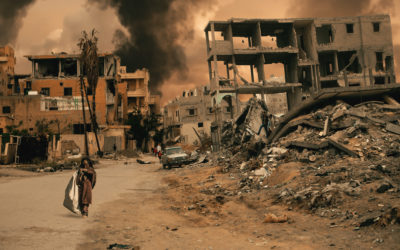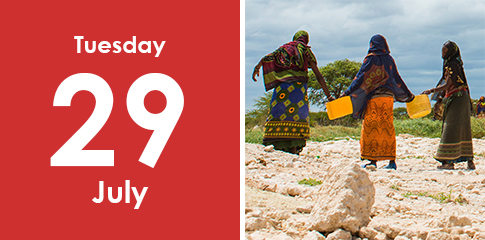It may seem as if the world is falling apart, as crises pile up and disease spreads.
This assertion of the former United Nations Secretary General Ban Ki Moon (opening of the 71st General Assembly – 24 September 2014) raises a fundamental question: how to reduce the vulnerabilities of populations affected by crises in a sustainable way?
This is crucial, especially in contexts where the development has not yet met the basic needs of people. The establishment of strong linkages between humanitarian and development programmes is essential in the response to the needs of populations in fragile and crisis-affected situations. It should be developed around three main pillars:
-
Strengthening of capacities and systems1 that deliver essential services
-
Risk-informed programming in fragile contexts
-
Participation of affected populations
Strengthening social service systems most subject to conflict and security shocks and stresses
In fragile areas and other long-lasting conflicts, a strong social
service system is critical to reduce long-term risks, prevent future
crises and build more resilient societies. In such crises where schools
are targeted and basic social services destroyed or controlled by armed
groups, most children are deprived of their right to education and
access to services for communities is limited.
Meanwhile, mass displacement of population creates severe stress in host
communities with a high risk of conflicts around services and
livelihood. Increasing investments for social services in hot spots of
deprivation areas (including geographical convergence of sectors) will
contribute to delivering better assistance for affected communities
while building their long-term resilience.
For example, a strong and decentralised primary health care system in areas most susceptible to conflict, the construction of schools that are more resilient to security threats, and the development of sustainable water infrastructures in crisis-affected communities can bridge emergency interventions with longer term development perspectives and, in turn, contributing to tackle the root causes of conflicts in fragile areas. Such results can be achieved if further efforts are made to increase and support investments in the institutional capacities of local and national stakeholders.
Risk-informed programming to prevent, mitigate and provide better response
Protracted conflicts, especially in fragile contexts, create shocks and stress for affected communities. To this end, development and humanitarian actors must recognise that the suffering and damage related to long-lasting conflict can be greatly reduced through new ways of working. In particular, analyses show that risk-informed programming helps to prevent, mitigate and prepare for crisis. In fact, by definition, risk-informed programming entails strengthening resilience to shocks and stresses by identifying and addressing the root causes and drivers of risk, including vulnerabilities, lack of capacity and exposure to various shocks and stresses.2
Risk analysis informs humanitarian and development strategies that
aim to build more resilient service delivery systems, national and local
governments and communities. In doing so, risk-informed programming
contributes to addressing underlying risk factors, promotes a do-no-harm
approach, strengthens short-term preparedness and can bolster existing
service delivery systems. This approach can reduce vulnerability while
also meeting humanitarian needs in all contexts, whether chronic acute
emergencies and fragile settings or more stable contexts hit by
sudden-onset crises.
Engagement and participation of affected populations, a forgotten crucial component
Affected people are at the center of humanitarian response. Communities are also key partners in the positive role sustainable development can play in mitigating the drivers of conflicts and complex emergencies, and in building preparedness for future crises.
Unfortunately, engagement of people suffering from crisis is a component that is often overlooked in development interventions and humanitarian response. During major events such as the Ebola virus outbreaks in DRC and West Africa or the complex crises taking place in Central Sahel, the insufficiency or lack of accountability and participation of affected population is the major driver cause of resistance, refusal and violence.
Accountability is a key element in fostering engagement and participation. It is “an active commitment by humanitarian actors and organisations to use power responsibly by taking account of, giving account to and being held to account by the people they seek to assist. It requires humanitarian actors to involve people affected by crisis in key decisions and processes that impact them…. Feedback and complaints mechanisms are required so that problems can be addressed, and appropriate action taken”.3
Bridging humanitarian with development supposes that the views of
affected people informs the preparedness and response and long-term
actions that meet their needs and strengthen their resilience to future
shocks. In that way, engaging them requires space to voice their
distinct needs, using that feedback to inform the design and provision
of services and take corrective measures.
1 Here we consider “system” as all the organizations, institutions and resources which are dependent and working together to deliver a social basic service to meet the needs of target populations or communities. Example: health system, education system. Capacities refer to institutional and technical capacities to deliver a given service or work.
2 UNICEF paper to the Executive Board, 5-7 February 2019, New York
3 IASC (2017), Collective Accountability to Affected People Practical steps for Humanitarian Coordinators and Humanitarian Country Teams (https://interagencystandingcommittee.org)
SANSAN HIEN, DPP’17
Communication for Development Officer (Humanitarian and Development), UNICEF – Burkina Faso
shien@unicef.org, hien.sansanb@gmail.com









0 Comments